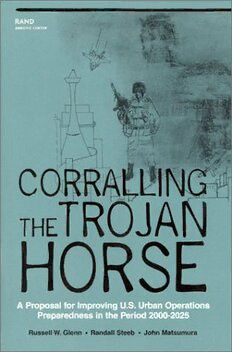
Coralling the Trojan Horse: A Proposal for Improving U.S. Urban Operations Preparedness in the Period 2000-2025 (Documented Briefing Rand Corporation) PDF
36 Pages·2001·0.669 MB·English
Most books are stored in the elastic cloud where traffic is expensive. For this reason, we have a limit on daily download.
Preview Coralling the Trojan Horse: A Proposal for Improving U.S. Urban Operations Preparedness in the Period 2000-2025 (Documented Briefing Rand Corporation)
Description:
This study presents an alternative to continued reliance on close combat urban operations paradigms that require a commitment of large numbers of soldiers to urban actions. It has six mutually reinforcing, largely simultaneous components: intelligence, surveillance, and reconnaissance enhancements; denial of access; nodal operations; noncombatant control; selective dominance; and post-conflict sustainment. Although the analysis largely focuses on combat operations, these elements are also applicable to serving objectives inherent during stability and support missions, whether these are part of a larger combat contingency or themselves dominate actions in the theater of operations. The period considered is 2000-2025. There is continuity inherent in the analysis. It is recognized that reaching the desired end state of a much improved way of conducting urban operations demands somewhat consistent fiscal policies, technological development, and leader support over that span of years.
See more
The list of books you might like
Most books are stored in the elastic cloud where traffic is expensive. For this reason, we have a limit on daily download.
